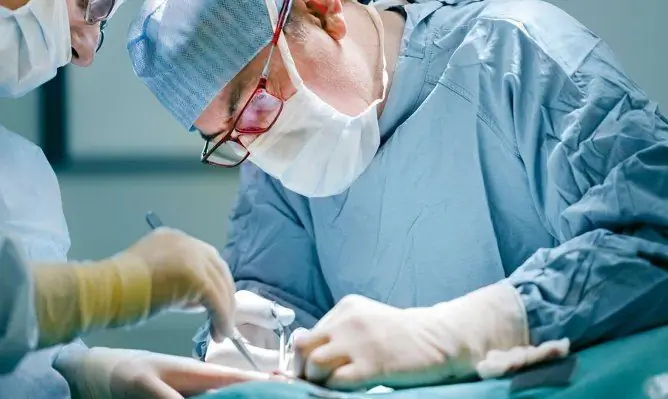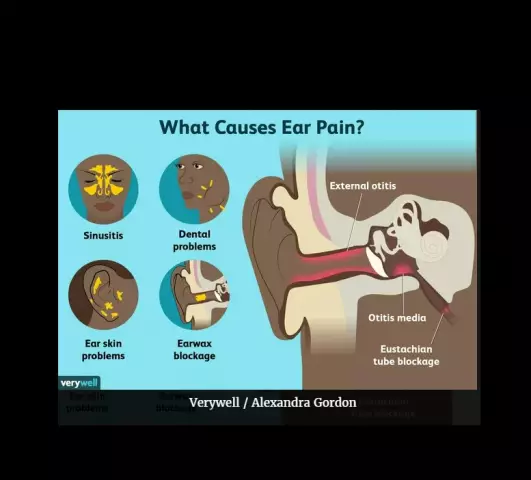- Author Rachel Wainwright [email protected].
- Public 2023-12-15 07:39.
- Last modified 2025-11-02 20:14.
Surgery - new in postoperative pain management
The technique of wound irrigation (wound infiltration) as a solution to the problem of pain in the postoperative period.

In contrast to the subjective experience of many anesthesiologists, the failure of the currently widely used epidural anesthesia for postoperative pain relief is a frequent clinical problem.
In a meta-study of 17,215 surgical patients, epidural failure rates ranged from 13% to 47.1%. According to the US National Health Center, 4.3 million patients suffer from acute postoperative pain - more than 50%. One of the largest studies in the UK (20 thousand patients) found that more than 40% suffer in the postoperative period from pain of moderate to high intensity. According to WHO and the International Association for the Study of Pain, the current state of affairs is considered unsatisfactory.
The number of failed attempts at epidural analgesia is not the only reason for the decline in this approach. And the decision about whether to continue using epidural analgesia should be supported by regular institutional reviews and an accurate assessment of the risk / benefit ratio, rather than being dictated by accepted practice. For traditional postoperative pain relief, epidural analgesia is no longer considered the gold standard.
Today it is no longer a secret that the main causes of morbidity and mortality from surgery are the surgery itself, the professional experience of the surgeon, the stressful response to the trauma and concomitant diseases of the patient. Postoperative anesthesia is a major component of the entire treatment process and local anesthesia techniques, which are more effective than systemic anesthesia, regardless of the operation and method of delivery of the anesthetic.
Today, the technique of wound irrigation or the technique of wound infiltration, as it is commonly called in the world of medicine, is becoming more and more famous as a technique of postoperative anesthesia, when at the end of the operation a special irrigation catheter for local, rather than system-wide, irrigation is installed in the patient's peri-wound space. The spread of this technique was facilitated by the recognition by the medical community of new generation devices that meet the requirements of this method of pain relief. The method of infiltration of wounds is aimed at early rehabilitation of the patient by rejecting general systemic means of pain relief. The effectiveness and technical simplicity of this technique supports its wide clinical application and is supported by a large number of scientific articles comparing the level of pain, the general condition of the patient,length of hospital stay and other parameters with epidural anesthesia and opiate pain relievers.
The technique of wound irrigation has scientifically and practically proven itself in postoperative pain relief in the following areas of surgery:
- Pediatrics
- general surgery
- Cardiac surgery
- Thoracic surgery
- Orthopedics
- Gynecology
- Oncology
- Urology
- Vertebrology
- Endoprosthetics
- Plastic surgery.
The wound irrigation technique is aimed at:
- A radical solution to the problem of postoperative pain
- The fastest possible patient rehabilitation process
- Reduced hospitalization time
- Reduced incidence of postoperative complications
- Solving chronic pain problems
- Reducing the risk of re-hospitalization.
The wound infiltration technique today provides answers to such problematic areas of application of epidural anesthesia as:
- Lack of evidence of a decrease in the incidence of postoperative complications in low and medium-risk patients;
- The use of accelerated, non-epidural, with a rapid resumption of physical activity, postoperative recovery programs;
- Lack of strong evidence of the cost-effectiveness of epidural techniques despite decades of use;
- The problem of conflicting opinions regarding serious neurological complications.
In conclusion, it should be noted that the wound infiltration technique, being simple, safe and effective, can be applied, although not for everyone, but for many surgical procedures in the postoperative period. Therefore, this technique should, both separately and as a component, be part of a balanced multimodal pain relief regimen.
Found a mistake in the text? Select it and press Ctrl + Enter.






